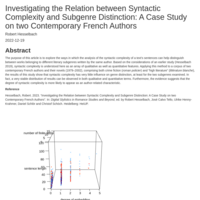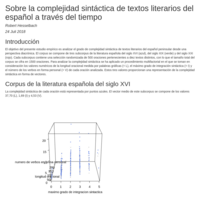Recently Published

Investigating the Relation between Syntactic Complexity and Subgenre Distinction: A Case Study on two Contemporary French Authors
The purpose of this article is to explore the ways in which the analysis of the syntactic complexity of a text’s sentences can help distinguish between works belonging to different literary subgenres written by the same author. Based on the considerations of an earlier study (Hesselbach 2019), syntactic complexity is understood here as an array of qualitative as well as quantitative features. Applying this method to a corpus of two contemporary French authors and their novels (1979–2002), comprising both crime fiction (roman policier) and “high literature” (littérature blanche), the results of this study show that syntactic complexity has very little influence on genre distinction, at least for the two subgenres examined. In fact, a very stable distribution of results can be observed in both qualitative and quantitative terms. Furthermore, the evidence suggests that the degree of syntactic complexity is more likely to appear as an author-related characteristic.

Diaphasische Variation und syntaktische Komplexität - eine empirische Studie zu funktionalen Stilen des Spanischen mit einem Ausblick auf das Französische
In der hier vorliegenden, synchron ausgerichteten Studie werden verschiedene funktionale Stile des europäischen Spanisch in Bezug auf den Grad der syntaktischen Komplexität untersucht. Dabei handelt es sich um umgangssprachliche Konversationen (COL), um Politikerinterviews (POL), um Parlamentsreden (PAR), um wissenschaftliche Literatur (CIE) und um Gesetzestexte (LEG). Abschließend wird in einer kontrastiven Perspektive ein Vergleich gezogen zwischen dem CIE-Korpus und einem Korpus wissenschaftlicher Texte des Französischen (SCI). Neben der qualitativen Beschreibung der einzelnen Satzkonstruktionen werden für die quantitative Analyse der Komplexität verschiedene numerisch messbare Werte herangezogen und in einer Vektordarstellung vereint. Dazu gehören die Satzlänge in graphischen Wörtern (=SL), die Anzahl der finiten Verben (=FV) sowie der Grad der maximalen Einbettungstiefe (=ET).

Sobre la complejidad sintáctica de textos literarios del español a través del tiempoent
El objetivo del presente estudio empírico es analizar el grado de complejidad sintáctica de textos literarios del español peninsular desde una perspectiva diacrónica. El corpus se compone de tres subcorpus de la literatura española del siglo XVI (azul), del siglo XIX (verde) y del siglo XXI (rojo). Cada subcorpus contiene una selección randomizada de 500 oraciones pertenecientes a diez textos distintos, con lo que el tamaño total del corpus se cifra en 1500 oraciones. Para analizar la complejidad sintáctica se ha aplicado un procedimiento multifactorial en el que se toman en consideración los valores numéricos de la longitud oracional medida por palabras gráficas (= L), el máximo grado de integración sintáctica (= I) y el número de los verbos en forma personal (= V) de cada oración analizada. Estos tres valores proporcionan una representación de la complejidad sintáctica en forma de vectores.